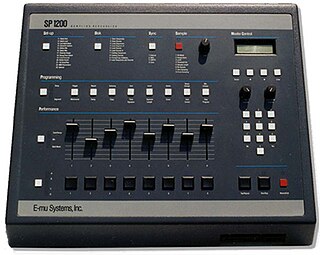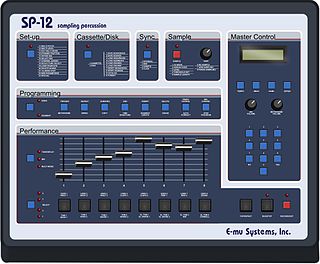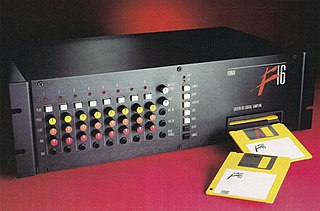A millisecond is a unit of time in the International System of Units equal to one thousandth of a second or 1000 microseconds.

The Fairlight CMI is a digital synthesizer, sampler, and digital audio workstation introduced in 1979 by Fairlight. It was based on a commercial licence of the Qasar M8 developed by Tony Furse of Creative Strategies in Sydney, Australia. It was one of the earliest music workstations with an embedded sampler and is credited for coining the term sampling in music. It rose to prominence in the early 1980s and competed with the Synclavier from New England Digital.
Akai is a Hong Kong manufacturer of consumer electronics. It was founded as Akai Electric Company Ltd in Tokyo, Japan, in 1946.
A music workstation is an electronic musical instrument providing the facilities of:

A sampler is an electronic musical instrument that records and plays back samples. Samples may comprise elements such as rhythm, melody, speech, sound effects or longer portions of music.
Steinberg Media Technologies GmbH is a German musical software and hardware company based in Hamburg. It develops software for writing, recording, arranging and editing music, most notably Cubase, Nuendo, and Dorico. It also designs audio and MIDI hardware interfaces, controllers, and iOS/Android music apps including Cubasis. Steinberg created several industry standard music technologies including the Virtual Studio Technology (VST) format for plug-ins and the ASIO protocol. Steinberg has been a wholly owned subsidiary of Yamaha since 2005.

The Emulator is a series of digital sampling synthesizers using floppy-disk storage that was manufactured by E-mu Systems from 1981 until 2002. Although it was not the first commercial sampler, the Emulator was innovative in its integration of computer technology and was among the first samplers to find widespread usage among musicians. While costly, its price was considerably lower than those of its early competitors, and its smaller size increased its portability and, resultantly, practicality for live performance. The line was discontinued in 2002.
Sequential is an American synthesizer company founded in 1974 as Sequential Circuits by Dave Smith. In 1978, Sequential released the Prophet-5, the first programmable polyphonic synthesizer, which was widely used in the music industry. In the 1980s, Sequential was important in the development of MIDI, a technical standard for synchronizing electronic instruments.

Logic Pro is a proprietary digital audio workstation (DAW) and MIDI sequencer software application for the macOS platform developed by Apple Inc. It was originally created in the early 1990s as Notator Logic, or Logic, by German software developer C-Lab which later went by Emagic. Apple acquired Emagic in 2002 and renamed Logic to Logic Pro. It was the second most popular DAW – after Ableton Live – according to a survey conducted in 2015.

The Prophet-5 is an analog synthesizer manufactured by the American company Sequential. It was designed by Dave Smith and John Bowen in 1977. It was the first polyphonic synthesizer with fully programmable memory.
The 405-line monochrome analogue television broadcasting system was the first fully electronic television system to be used in regular broadcasting. The number of television lines influences the image resolution, or quality of the picture.
The Akai S900 is a 12-bit sampler, with a variable sample rate from 7.5 kHz through to 40 kHz. It was common in recording studios until it was superseded two years later by the S1000.

The E-mu SP-1200 is a sampling drum machine designed by Dave Rossum and released in August 1987 by E-mu Systems. Like its predecessor, the SP-12, it was designed as a drum machine featuring user sampling. The distinctive character of its sound, often described as "warm," "dirty," and "gritty," and attributed to SP-1200's low 26.04 kHz sampling rate, 12-bit sampling resolution, drop-sample pitch-shifting, and analog SSM2044 filter chips (ICs), has sustained demand for the SP-1200 more than thirty-five years after its debut, despite the availability of digital audio workstations and samplers/sequencers with superior technical specifications.

The Korg DSS-1 is a polyphonic sampling synthesizer released by Korg in 1986. As Korg's initial entry into the sampling market, the DSS-1 combines sampling, additive synthesis, and waveform drawing with an analog signal path. The DSS-1 was released a time when major synthesizer manufacturers like Yamaha and Casio were beginning to explore sampling, an area of sound design dominated by companies like Fairlight, E-mu, and Ensoniq. Korg did not stay long in the sampling arena; the DSS-1 was the company's only sampler until 1998 when Korg introduced sampling options on their Triton and Trinity series of workstations.
The Akai S1000 is a 16-bit, 44.1 kHz professional stereo digital sampler, released by Akai in 1988. The S1000 was among the first professional-quality 16-bit stereo samplers. Its abilities to splice, crossfade, trim, and loop sound in 16-bit CD quality made it popular among producers in the late 80s through to the mid 90s. The S1000 used 24-bit internal processing, had digital filters and an effects send and return, and came with 2MB of RAM.

E-mu Systems was a software synthesizer, audio interface, MIDI interface, and MIDI keyboard manufacturer. Founded in 1971 as a synthesizer maker, E-mu was a pioneer in samplers, sample-based drum machines and low-cost digital sampling music workstations.

aptX is a family of proprietary audio codec compression algorithms owned by Qualcomm, with a heavy emphasis on wireless audio applications.
The Prophet 2000 is a sampler keyboard manufactured by Dave Smith's Sequential Circuits (SCI) and released in 1985. It was the company's first sampler, and, despite its low audio fidelity and technical limitations by modern standards, marked a shift toward affordable samplers with better audio quality than its predecessors. It is also considered to be one of the earliest multitimbral samplers.

The E-mu SP-12 is a sampling drum machine. Designed in 1984, SP-12 was announced by E-mu Systems in 1985. Expanding on the features of E-mu’s affordable and commercially successful Drumulator, a programmable digital drum machine, SP-12 introduced user sampling, enabling musicians to sample their own drums and other sounds. In August 1987, E-mu replaced SP-12 with SP-1200.

The Forat F16 is the first 16 bit digital sampler optimized for use as an electronic drum module. It dynamically responds to trigger inputs from MIDI and/or audio signals. With a response time of 0.1 milliseconds, the F16 is the fastest audio triggering digital sampler ever sold. It was manufactured by Forat Music and Electronics, introduced in 1987 at a list price of $5200 and was discontinued in 1994. An optional Remote Control and SCSI capability was available for $1385.










